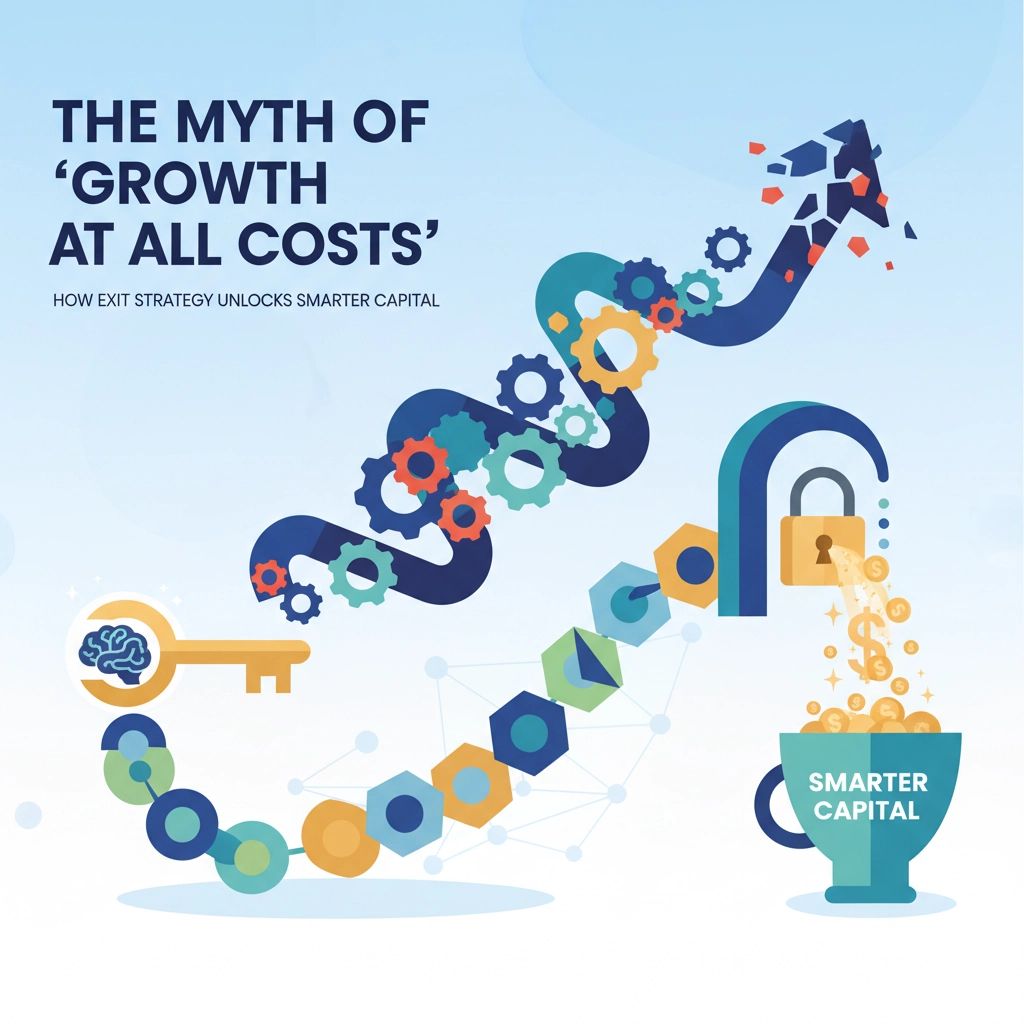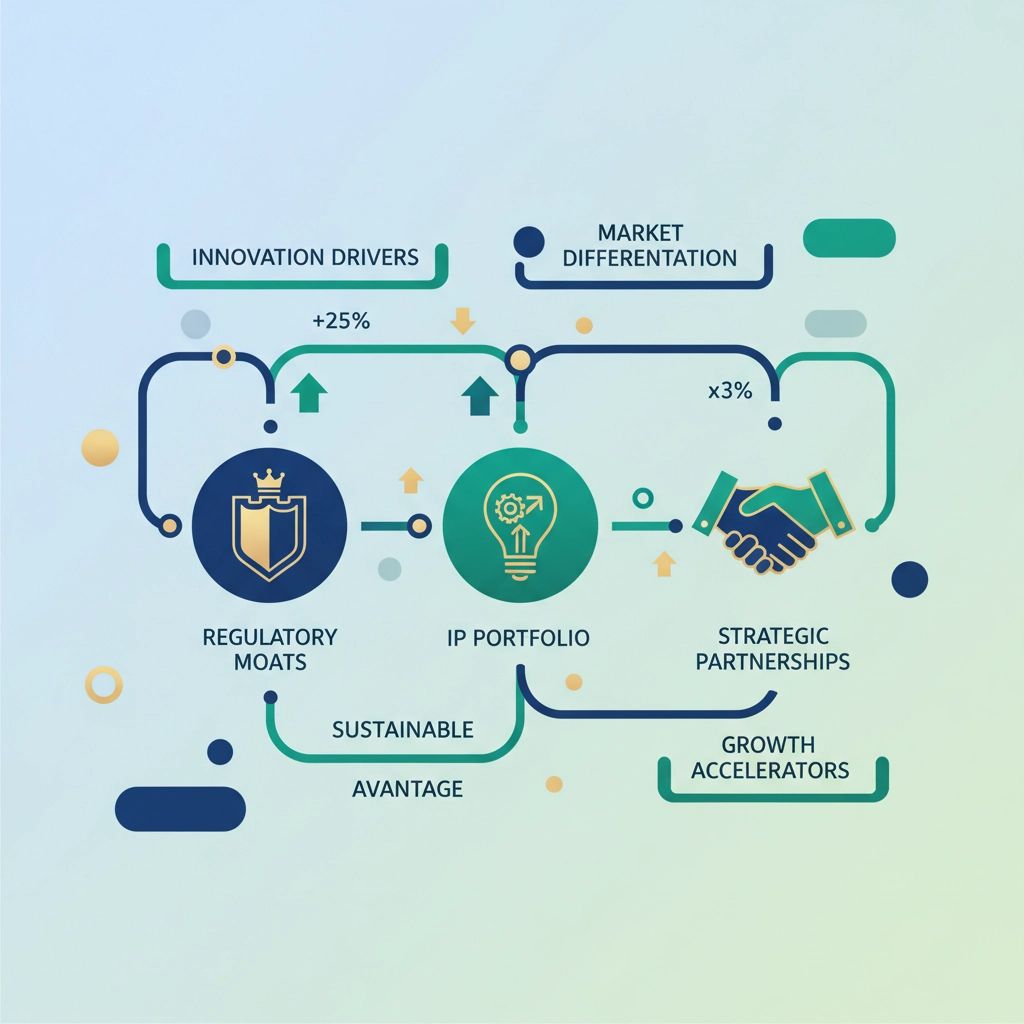The Myth of 'Growth at All Costs': How Exit Strategy Unlocks Smarter Capital
Oct 01, 2025
Here's the brutal truth that 92% of deeptech and healthtech founders refuse to admit: your relentless pursuit of growth metrics is actually repelling the smartest capital in the market.
While you're burning through runway chasing vanity KPIs, strategic investors are quietly backing founders who've cracked the code on something far more valuable, exit-driven decision making that magnetizes premium capital.
🚨 The Growth-at-All-Costs Trap Is Killing Deeptech & HealthTech Startups
Stop right here if this sounds familiar:
You're pre-Series A, building breakthrough AI diagnostics or quantum computing solutions. Your metrics look impressive, user growth is up 300%, you've got pilot programs with three Fortune 500s, and your technology is genuinely revolutionary.
But here's what's actually happening behind the scenes:
- Your burn rate is unsustainable because you're scaling teams before proving unit economics
- You're saying yes to every partnership that boosts user numbers, diluting your core value proposition
- Smart money keeps passing because they can't see a clear path to strategic value creation
- You're optimizing for the wrong metrics that won't matter in 18 months when Series A conversations begin

The deeptech/healthtech sectors are littered with "promising" startups that raised seed rounds on growth potential and died during Series A because investors couldn't see strategic exit value.
💡 Why Exit Strategy Actually Accelerates Capital Flow (Counterintuitive But True)
Here's what the most successful deeptech and healthtech founders figured out early: Capital follows clarity, not just growth.
When you anchor every major decision to potential exit outcomes, something magical happens. You start making choices that create strategic value rather than just operational metrics.
Take this real example:
Two AI diagnostics companies raised seed rounds in the same quarter. Company A focused on user acquisition: they hit 50K healthcare professionals using their platform. Company B focused on regulatory pathway optimization and IP portfolio development: they had 5K users but clear FDA approval strategy and defensible technology moats.
Guess which one closed their Series A 6 months faster?
Company B. Because they weren't just building a product: they were building an asset that strategic acquirers would fight over.
🎯 The Strategic Value Framework That VCs Actually Want to Fund
Smart capital doesn't just want to see growth. They want to see compounding strategic advantages that become more valuable over time.
Here's the framework that's working for seed and Series A deeptech/healthtech founders:
1. Regulatory Moats > User Growth
Instead of chasing pilot programs, focus on building regulatory advantages that competitors can't replicate quickly. FDA breakthrough device designations, CE marks, or clinical trial partnerships create defensible value that scales exponentially.
2. IP Portfolio Strategy > Feature Development
Every R&D dollar should strengthen your patent position around core innovations. Strategic acquirers pay premium multiples for technology they can't build internally or license elsewhere.
3. Strategic Partnership Quality > Partnership Quantity
One exclusive partnership with a market leader is worth more than fifty pilot programs. Focus on relationships that create mutual dependence and switching costs.
🔥 How Exit-Focused Founders Are 10X-ing Their Funding Speed
The data doesn't lie: Deeptech and healthtech startups with clear exit positioning raise capital 67% faster than those focused purely on growth metrics.
Here's exactly what they're doing differently:
They Present Strategic Scenarios, Not Just Financial Projections
Instead of: "We'll reach $10M ARR in 24 months"
They say: "We're building the technology stack that [BigTech/BigPharma] will need to own to stay competitive in [specific market], and here's why they'll pay premium multiples to acquire it."
They Build for Strategic Value, Not Just Revenue
Exit-focused founders ask: "What would make Google/Johnson & Johnson write a $500M check for our technology?" Then they build toward that outcome.
This changes everything:
- Product roadmap priorities align with strategic buyer needs
- Team hiring focuses on capabilities that increase acquisition value
- Partnership strategy creates competitive advantages, not just revenue streams
They Time Market Consolidation Cycles
Smart founders study acquisition patterns in their sectors. They know that healthcare IT consolidates every 3-4 years, and quantum computing is entering a major M&A cycle right now.
They position themselves to be acquired during peak market conditions, not just when they need cash.
📈 Real-World Example: How One HealthTech Founder Turned Exit Strategy Into Capital Magnet
Meet Sarah (name changed), CEO of a Series A digital therapeutics startup.
The Old Approach: Sarah spent 18 months chasing patient engagement metrics. Her app had 100K downloads and impressive retention rates. But Series A investors kept asking the same question: "How does this become a billion-dollar outcome?"
The Exit Strategy Pivot: Sarah repositioned her entire company around one insight: Pharma companies desperately need digital biomarkers for clinical trials, and her technology could provide the most comprehensive dataset in the market.
New focus areas:
- Clinical validation studies that generated IP-protected datasets
- Partnerships with CROs that created exclusive data licensing opportunities
- Regulatory strategy that positioned her platform as the gold standard for digital endpoints
The result? Sarah closed her Series A in 4 months at a 40% premium valuation. Why? Because investors could clearly see multiple strategic exit paths: acquisition by pharma, licensing to CROs, or public market opportunity as a data-first healthcare platform.

⚡ Your 90-Day Action Plan: Turn Strategy Into Capital Magnet
Stop optimizing for vanity metrics. Start building for strategic value.
Week 1-2: Exit Scenario Mapping
- Identify 3-5 potential strategic acquirers in your space
- Research their recent M&A activity and acquisition criteria
- Map your technology/IP to their strategic gaps
Week 3-4: Strategic Value Audit
- List all your current partnerships, IP, regulatory assets, and team capabilities
- Score each asset on strategic value to potential acquirers (1-10 scale)
- Identify the top 3 areas that could 10X your strategic value
Week 5-8: Resource Reallocation
- Redirect 40% of your R&D spend toward building strategic moats
- Prioritize partnerships that create mutual dependence with market leaders
- Hire team members with experience at your target acquirer companies
Week 9-12: Investor Communication Reset
- Rebuild your pitch deck around strategic exit scenarios
- Create materials that show multiple paths to strategic value creation
- Start conversations with investors who've backed similar strategic exits
🎯 This Is For You If...
✅ You're a seed or Series A deeptech/healthtech founder
✅ You have breakthrough technology but struggle to articulate strategic value
✅ Investors like your product but question your path to large outcomes
✅ You want to raise your next round 2X faster at premium valuations
✅ You're ready to build for strategic exits, not just revenue milestones
🚀 Ready to Turn Your Exit Strategy Into a Capital Magnet?
The founders who master exit-driven capital strategy don't just raise money faster: they build companies that strategic acquirers fight to own.
Your breakthrough technology deserves strategic capital that understands its true potential. Stop chasing growth theater and start building strategic value that compounds.
Join our exclusive community of exit-focused deeptech and healthtech founders who are rewriting the rules of capital raising.
Let's go! 💥
